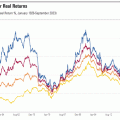Falling US petrol prices are boosting hopes that the worst wave of inflation in decades is fading, just as Joe Biden begins a campaign to convince sceptical voters that they are better off with a Democrat in the White House.
The average cost of a gallon of regular gasoline could fall below $3 in the coming days, well below the record highs above $5/g struck in the summer of 2022 — a time when soaring costs for groceries and rent were also squeezing household budgets.
In a nation of big cars, drivers are feeling the relief.
“Oh my God, it was terrible,” said Danis, an Uber driver from Paterson, New Jersey, as he began his shift on Monday night. “It cost like $80 or more to fill my tank. Now it takes $40-$42.”
Fair or not, many Americans judge their economy’s health — and a president’s performance — by the petrol price numbers that flash along streets and highways up and down the country. Pump prices help shape consumers’ mood, say analysts.
“Gas prices are always displayed very prominently. And when you actually go and fill up, you’re standing there watching the number on the ticker rise,” said Claudia Sahm, a former Fed economist and founder of Sahm Consulting.
While gasoline’s weighting in the CPI basket is just over 3 per cent, economists believe it plays an outsized role, alongside food, in shaping expectations of future price changes.
“The relationship between expectations and gasoline isn’t quite as perfect as it has been in the past. But they’re still very important,” said Gisela Hoxha, an economist at Citi.
Petrol prices can also change fast. The latest PCE data, out on Friday, show energy goods and services fell 2.7 per cent over the course of November, leading to an outright drop in headline prices of 0.1 per cent.
“People still face gasoline prices very often. It’s the same with food prices — you go to the grocery store all the time. While other prices do matter for inflation expectations, these are the two that consumers see very frequently.”
Donald Trump and other Republican opponents of Biden seized on those inflation indicators as fuel costs soared in 2021, trying to pin the blame for the petrol price run-up on the president’s climate agenda and policies to improve car engines’ fuel economy.
“The average licensed driver in America consumes about 600 gallons of gasoline a year. Nearly 80 per cent of new vehicles sold are SUVs or trucks,” said Kevin Book, head of research at Washington consultancy ClearView Energy Partners. “You don’t get reelected in America [by] putting large people into small cars.”
Biden hailed the November PCE report as a “significant milestone” in returning inflation to its pre-pandemic norms, highlighting the falls in the prices of essential goods, including petrol, ahead of the holiday season.
While falling inflation and a robust labour market have made economists more optimistic about a soft landing for the world’s largest economy, public sentiment is moving more slowly.
An FT-Michigan Ross poll in November showed that just 14 per cent of respondents thought they were better off under Biden. That’s despite US workers enjoying a 2.8 per cent rise in their real incomes between the third quarter of 2019 and the same quarter of this year, according to Treasury statistics.
Still there are signs of hope for the White House. The more recent FT-Michigan Ross poll, from December, showed that while many people remain angry about inflation, 22 per cent of respondents — the largest share — blame oil and gas majors for the price pressures. Other polling indicates that voters’ expectations for inflation are beginning to come down too. The latest University of Michigan sentiment poll also showed voters are becoming more optimistic about the economy, with supporters of both parties more positive on current conditions in December than at any point since the summer.
Weeks of pump price deflation are partly behind that change, say economists. Oil market analysts think another bout of fuel price inflation of the kind seen after Russia invaded Ukraine is unlikely. Prices could even go lower.
While costs differ vastly across the country — ranging from $4.58/g in California to $2.66 in Mississippi — US pump prices tend to track movements in crude oil markets.
US crude prices have fallen by 20 per cent since September, pushed down by weaker than expected global demand, surging shale production in Texas, and a seasonal dip in US consumption.
Recent turmoil in the Middle East has halted some of crude’s slide, but an uncertain macroeconomic climate means global oil demand growth — which hit a record high in 2023 — may be more sluggish next year. That could weigh on petrol prices just as the 2024 presidential election campaign picks up in earnest.
The more benign outlook for petrol prices will feed into a fairly healthy picture for the US economy as a whole. The Federal Reserve expects the country’s jobs market to stay reasonably strong in 2024, with unemployment picking up only slightly from 3.8 per cent now to 4.1 per cent. So long as wages keep rising faster than inflation, the combination should also lift public sentiment, believe economists.
“People are still living with high prices, and that is something that people don’t like,” Fed chair Jay Powell acknowledged last week after the central bank’s most recent rate-setting meeting. “Wages are now moving up more than inflation, and as inflation comes down and that might help improve the mood.”
If petrol costs are the most visible symbol of that improvement, the forecourt price drop could even help Biden in Republican-leaning, lower-income areas of the country, where spending on gasoline accounts for a disproportionate share of household budgets.
Some of those kinds of drivers — and voters — are in parts of Michigan, Georgia and Wisconsin, swing states that will be critical in next year’s election. Gas prices in each are now well below $3/g (or about 63p per litre), and they have been trending lower in other battlegrounds such as Arizona, Nevada and Pennsylvania too, according to AAA, a motorists’ group.
“People in red states do tend to do more driving on smaller disposable incomes than in blue states,” said Book. “It’s really an issue for people in the lower-middle income ranges, where there’s an intersection of limited means and a significant need for transportation.”
Despite the sharp deflation in petrol prices in recent months, however, a gallon of the fuel still costs more now than it did before Biden entered the White House. And while inflation is easing for other goods, prices are still rising — just more slowly.
“Gas prices are going down, but everything else is still going up,” said Hazel, who travels to her job in retail in Washington by car. “People attack Trump, but he did get some things done on the economy. With Biden it’s all been downhill.”





